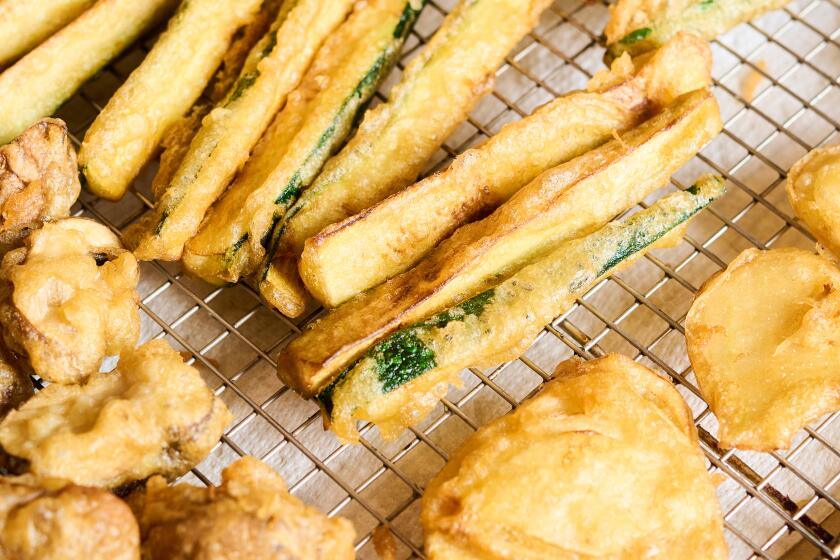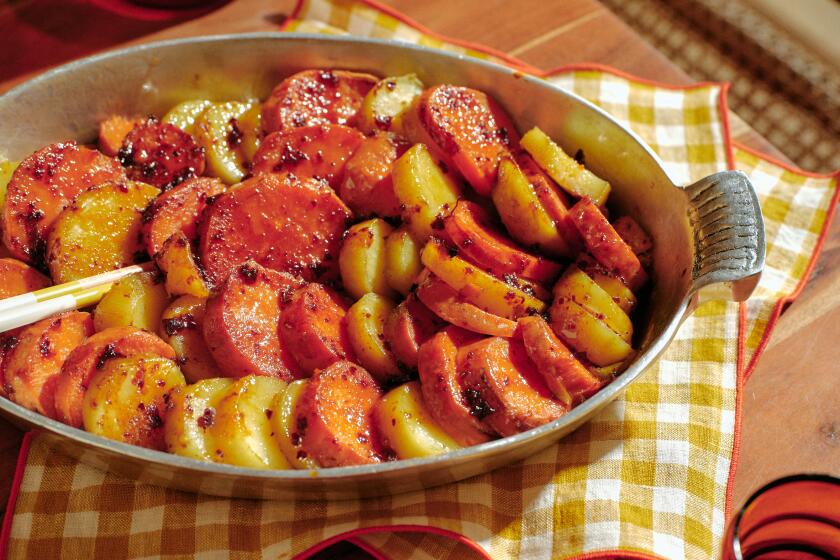Glazed vegetable melange
- Share via
Of the many ways to transform produce, glazing is among the most dramatic. Adding butter and herbs is a mere cosmetic makeover, while steaming is just a spa treatment. Glazing is a total face-lift.
And this is beauty that is more than skin deep. Many vegetables, such as carrots or asparagus, can be seared in a bit of fat and finished with a reduction of stock or liquor so that their taste intensifies from the inside out while the surface glistens alluringly. There is no other way to impart that much flavor while improving the appearance.
Roasting withers. Glazing plumps.
Basically glazing is a three-step process: brief sauteing followed by slightly longer simmering and a quick reduction to create the highlights. But it works magic on any vegetables, whether spring babies just coming into season or those like winter squash with some life in them yet. Vegetables not only keep their shape and integrity with this treatment (pureeing is the witness protection program by comparison) but they also emerge with fuller, richer flavor.
In classic French cooking, root vegetables such as turnips, carrots and onions are glazed to create a garnish for roasts and stews, a little eye candy alongside the stodgy meat. But the technique can be a snazzier way of dressing up any vegetables to create an attention-grabbing side dish for lighter entrees such as grilled fish and poultry. Artichokes, asparagus, leeks, mushrooms and fennel all take to glazing like starlets to collagen.
Glazing sometimes involves sugar or honey or other sweeteners, but you can generally get the deepest flavor just by relying on two essential ingredients: fat and seriously good stock made from turkey, beef, chicken, duck or vegetables. The fat can be duck or bacon, butter or olive oil, even a nut oil, but it should always be something with great flavor. Consider it a foundation.
The stock should be full and rich too, because it will build on the flavor of the fat. And of course the best is homemade, well worth learning to make. (You can glaze with booze, particularly syrupy Cognacs and full-bodied wines, but vegetables seem to be fine teetotalers.)
Glazing produces such dramatic results that only salt and pepper are really needed for seasoning. You can reach for herbs or spices and aromatics, such as garlic or shallots, but those are often like gilding the lily. The layering of flavor of fat and stock is most important.
The technique is much like braising, except you generally use more liquid and cook away almost all of it so the vegetables are left glistening rather than drowning. The vegetables need to be cooked lid-on until they are tender, then uncovered to reduce the stock. That enclosed environment is like a steam bath for the toughest specimen.
Baby artichokes are a natural for glazing now, with bacon for the fat; just trim them well and cut them into quarters for even cooking. The same recipe would work wonders with asparagus or leeks or any infant squash, such as zucchini and pattypans, whole or halved.
You can also mix and match vegetables. Pearl onions and baby carrots are a classically French combination, but when you add baby fennel, you get an entirely new look, especially when you start the glaze with duck fat and end it with a little hot Aleppo or chipotle pepper for extra kick.
Glazed vegetables should be served as soon as the stock has reduced. Even cold, though, they will have assertive flavor. And still look fabulous.
Bring a small pot of water to a rolling boil. Add the onions and blanch 1 minute. Drain and cool, then slice off the ends and slip off the peel. Set aside.
Cut off the tops of the fennel bulbs and reserve 1 tablespoon of the green fronds. Wash the bulbs and trim off the root ends. Cut the bulbs crosswise into one-half inch slices. Set aside.
Heat the duck fat in a deep skillet over medium-high heat. Add the onions and cook, stirring constantly, 3 minutes. Add the fennel, carrots and salt and cook, stirring constantly, 2 minutes. Stir in the Aleppo pepper. Deglaze the pan with the stock.
Reduce the heat to low, cover the pan and cook 10 minutes or until the vegetables are tender. Stir in the maple syrup. Raise the heat again to medium-high and cook uncovered until the liquid is reduced to a glaze, a couple of minutes. Garnish with the reserved fennel fronds and serve.
Get our Cooking newsletter.
Your roundup of inspiring recipes and kitchen tricks.
You may occasionally receive promotional content from the Los Angeles Times.















